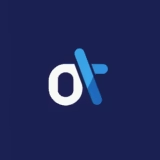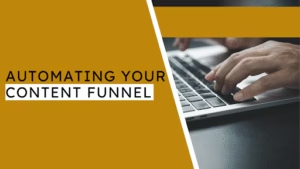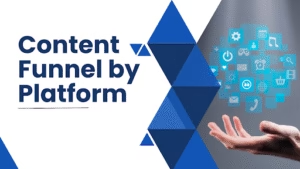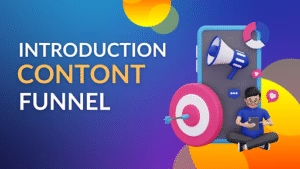
Introduction to Content Funnel
The digital marketing landscape has changed dramatically over the past decade. Consumers today don’t simply land on a website and make a purchase on the spot. Instead, they go through a multi-stage journey — researching, comparing, and evaluating before committing.
In fact, 77% of buyers spend more time researching before contacting sales than they did two years ago. This shift has made content funnels more important than ever.
A content funnel is the structured framework that aligns content creation with this buyer journey. Instead of throwing random blogs or ads into the void, a content funnel ensures that each piece of content is carefully crafted to educate, engage, and convert prospects at different stages of awareness.
Think of it as a roadmap: guiding cold strangers toward becoming warm leads and eventually, loyal customers.
By the end of this guide, you’ll not only understand what a content funnel is but also how to build, optimize, and scale one for long-term business success.
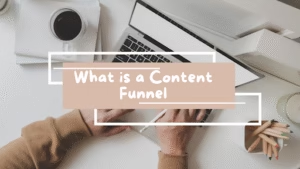
WHAT IS A CONTENT FUNNEL
A content funnel is a strategic approach to content marketing that maps different types of content to different stages of the customer journey. It ensures that you’re delivering the right message at the right time to move prospects down the funnel.
The funnel has three classic stages:
- Top of Funnel (TOFU) – Awareness
- Middle of Funnel (MOFU) – Consideration
- Bottom of Funnel (BOFU) – Decision
But modern content funnels also extend beyond BOFU, into post-purchase retention and advocacy, ensuring that customers become loyal fans and repeat buyers.
Quick analogy: Think of a first date. You don’t propose marriage instantly. First, you introduce yourself, build trust, and then ask for commitment. That’s what a content funnel does — gradually moving relationships forward.
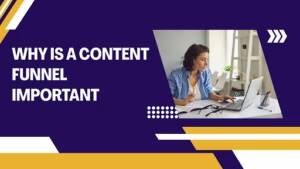
Why is a Content Funnel Important?
Many businesses fail at content marketing because they create content without context. They might have great blogs, videos, or infographics, but if these assets don’t connect with the buyer journey, they won’t generate meaningful results.
Here’s why content funnels are crucial:
- Aligns Content with Buyer Intent – Every piece of content is purposeful.
- Boosts ROI – Eliminates wasted content creation.
- Increases Conversion Rates – Warmed leads convert better.
- Builds Trust – Consistency creates authority in the niche.
- Supports Sales Teams – Provides qualified, nurtured leads.
- Improves Customer Experience – Personalized journeys enhance satisfaction.
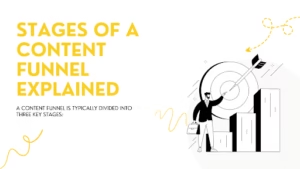
Stages of a Content Funnel Explained
A content funnel is typically divided into three key stages:
Top of Funnel (TOFU) – Awareness Stage
At this stage, your prospects may not even know they have a problem. The goal is to educate and attract through high-value, non-promotional content.
Best TOFU content examples:
- Blog posts
- Infographics
- Podcasts
- YouTube tutorials
- Social media posts
Example: A SaaS company could publish a blog titled “10 Signs Your Business Needs Workflow Automation.”
Middle of Funnel (MOFU) – Consideration Stage
Now prospects are aware of their challenges and actively looking for solutions. Your goal is to nurture and position your brand as the best choice.
Best MOFU content examples:
- Whitepapers & eBooks
- Webinars
- Case studies
- Comparison guides
- Email sequences
Example: Offering a “Guide to Choosing the Best Workflow Automation Tool” with a downloadable PDF.
Bottom of Funnel (BOFU) – Decision Stage
This is where the conversion happens. Prospects are ready to buy but need a little push. Content should focus on building confidence and reducing objections.
Best BOFU content examples:
- Free trials
- Demos
- Pricing pages
- Testimonials
- Limited-time offers
Example: A free 14-day trial plus video testimonials of happy clients.

Bonus Section: Industry-Specific Content Funnel Frameworks
Every industry has unique customer behaviors, which means content funnels must be tailored. Let’s look at how different businesses can structure their funnels.
B2B Content Funnel Framework
TOFU (Awareness)
- Whitepapers on industry trends
- SEO-optimized blogs like “Future of [Industry] in 2025”
- LinkedIn thought-leadership posts
MOFU (Consideration)
- Webinars with industry experts
- ROI calculators for your solution
- Detailed case studies
BOFU (Decision)
- Free consultations
- Product demos
- Customer testimonials with quantifiable results
Example: A B2B SaaS company like Salesforce uses TOFU blogs to capture leads, MOFU reports to show value, and BOFU free trials to close deals.
SaaS Content Funnel Framework
TOFU
- Free templates, guides, or checklists
- YouTube tutorials on solving industry pain points
- Interactive tools (like HubSpot’s “Website Grader”)
MOFU
- Email nurturing sequences
- Customer success stories
- Webinars showing real-world use cases
BOFU
- Limited free trial or freemium plan
- One-on-one product demos
- Comparison pages (“Why Choose Us vs. Competitors?”)
Example: Dropbox attracted users with free storage (TOFU), educated them on team collaboration features (MOFU), and converted them with paid plans (BOFU).
E-commerce Content Funnel Framework
TOFU
- Blogs on fashion/lifestyle trends
- Instagram reels & TikTok content
- Gift guides & seasonal inspiration
MOFU
- Product tutorials & styling videos
- Email campaigns with personalized recommendations
- Social proof through influencer partnerships
BOFU
- Discounts & time-sensitive offers
- Abandoned cart emails
- Customer reviews & testimonials
Example: Gymshark uses TOFU fitness content, MOFU influencer tutorials, and BOFU limited drops to create urgency and drive conversions.
Coaching/Consulting Content Funnel Framework
TOFU
- YouTube motivational videos
- Free ebooks or checklists (“10 Steps to [Result]”)
- Blog posts solving specific problems
MOFU
- Case studies with real clients
- Free group webinars or workshops
- Podcasts featuring guest experts
BOFU
- Free strategy sessions
- One-on-one calls
- Testimonials with emotional storytelling
Example: Tony Robbins funnels audiences from free YouTube speeches (TOFU), to webinars (MOFU), to high-ticket coaching programs (BOFU).
Bonus Section: Automating Your Content Funnel
Automation makes your funnel scalable and efficient. Instead of manually guiding each lead, you let software do the heavy lifting.
Key Areas of Automation
- Email Marketing Automation: Tools like Mailchimp, ActiveCampaign, and ConvertKit nurture leads with pre-written sequences.
- Lead Scoring: Assign points to leads based on actions (e.g., downloading an ebook = 10 points). High scorers move to BOFU automatically.
- Retargeting Ads: Facebook Pixel & Google Ads retargeting bring back lost visitors with relevant content.
- Chatbots & AI: Chatbots like Drift or Intercom engage leads instantly at TOFU/MOFU, while AI personalizes recommendations.
Pro Tip: Automating doesn’t mean being robotic. Keep messaging human and empathetic.
Bonus Section: Biggest Content Funnel Mistakes to Avoid
Even experienced marketers trip up. Avoid these common mistakes:
1.Too Much Selling at TOFU
- At awareness stage, people don’t want a pitch—they want answers.
2. Ignoring Mobile Users
- Over 65% of content consumption happens on mobile. Optimize for it.
3.Not Segmenting Audiences
- Sending the same content to all leads reduces relevance and kills engagement.
4.Weak CTAs
- Every piece of content should move the user closer to the next step.
5.No Follow-Up
- Leads often need multiple touches before converting. Don’t give up after one interaction.
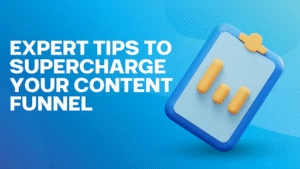
Bonus Section: Expert Tips to Supercharge Your Content Funnel
- Create Evergreen TOFU Content – Blogs that answer timeless questions keep generating traffic for years.
- Use Storytelling – Emotional connections drive conversions more than dry facts.
- Repurpose Content Across Stages – A webinar can become a blog, social posts, and a YouTube video.
- Leverage User-Generated Content (UGC) – Reviews, testimonials, and social proof build instant credibility.
- Test & Iterate – Run A/B tests on CTAs, emails, and landing pages to optimize conversion rates.
Content Funnel by Platform
Not all funnels are built the same. Different platforms require different funnel strategies. Let’s break it down:
Content Funnel on YouTube
YouTube is a goldmine for TOFU content because it ranks in both Google and YouTube search.
- TOFU: Tutorials, how-to videos, explainer content
- MOFU: Product comparisons, behind-the-scenes, customer stories
- BOFU: Demo videos, testimonials, direct CTAs to trial or purchase
Example: A SaaS brand might post “How to Organize Your Workflow” (TOFU), then “Trello vs. Asana: Which is Best?” (MOFU), and finally “Get Started with Trello Free Trial” (BOFU).
Content Funnel on LinkedIn
Perfect for B2B funnels.
- TOFU: Thought leadership posts, industry insights
- MOFU: Long-form LinkedIn articles, case studies, LinkedIn Lives
- BOFU: Personal outreach via InMail, free consultations
Example: A consulting firm might post “Top 5 HR Trends for 2025” (TOFU), then a case study on reducing employee turnover (MOFU), and finally an invite for a free HR audit (BOFU).
Content Funnel on TikTok & Instagram Reels
These platforms thrive on snackable, visual content.
- TOFU: Entertaining, viral, or educational short videos
- MOFU: Behind-the-scenes, tutorials, UGC
- BOFU: Limited-time offers, influencer shoutouts with direct CTAs
Example: A skincare brand posts “5 Skincare Hacks You Didn’t Know” (TOFU), then “How Our Serum Works on Real Skin” (MOFU), followed by “Shop Now – 20% Off Today Only” (BOFU).
Content Funnel via Email Marketing
Email is one of the highest ROI channels for funnels.
- TOFU: Lead magnets (ebooks, free guides, checklists)
- MOFU: Automated nurturing emails, case studies, event invites
- BOFU: Personalized offers, product demos, exclusive discounts
Pro Tip: Segment your list by user behavior. Someone who downloads an ebook isn’t at the same stage as someone who requested a demo.
Content Funnel on Blogs
Blogs remain the backbone of most funnels.
- TOFU: SEO-driven blogs targeting broad keywords
- MOFU: In-depth guides, comparison blogs, expert roundups
- BOFU: Product-focused blogs, buyer’s guides, testimonials
Example: Shopify ranks for “How to Start an Online Store” (TOFU), “Shopify vs. WooCommerce” (MOFU), and “Best Shopify Apps for Conversions” (BOFU).
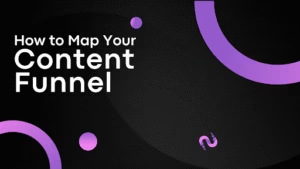
Step-by-Step: How to Map Your Content Funnel
Here’s a practical exercise you can apply today:
1.Define Your Goal
- Do you want more leads, sales, or subscriptions?
2.Identify Your Audience
- Create at least 2–3 buyer personas.
3.Audit Your Existing Content
- Map current blogs, videos, and emails to TOFU, MOFU, BOFU.
4.Fill the Gaps
- Missing MOFU content? Create case studies or webinars.
- Weak BOFU content? Add testimonials and free trials.
5.Distribute Content
- Choose 2–3 main channels where your audience spends time.
6.Set KPIs & Track
Use Google Analytics, CRM dashboards, or funnel tracking tools.
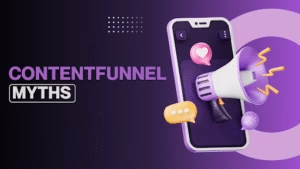
Content Funnel Myths (and the Truth)
Myth 1: Funnels are only for big businesses.
Truth: Even solopreneurs can build simple yet effective funnels.
Myth 2: Every funnel looks the same.
Truth: Funnels must adapt to your industry and audience.
Myth 3: Funnels = Sales Pages.
Truth: Funnels are about the entire journey, not just one page.
Myth 4: Funnels are static.
Truth: They must evolve based on analytics and market trends.
Myth 5: Funnels replace human connection.
Truth: They support connection by guiding people to the right content at the right time.
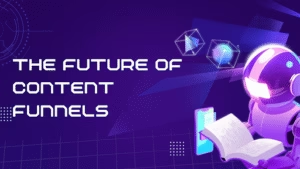
The Future of Content Funnels: 2030 Predictions
Content funnels will keep evolving. Here’s what to expect by 2030:
- Hyper-Personalization with AI: Funnels that change dynamically in real time for each visitor.
- Voice Search Funnels: More content optimized for Alexa, Siri, and Google Assistant.
- Augmented Reality Funnels: Try-before-you-buy experiences for ecommerce.
- Community-Driven Funnels: More brands using Discord, Slack, and private groups as MOFU channels.
- Data-First Funnels: With privacy regulations, funnels will rely on first-party data (email, community signups) instead of third-party cookies.
Expanded Conclusion
The content funnel is no longer optional—it’s essential. Whether you’re a solo creator, a startup, or a Fortune 500 company, a well-structured funnel ensures your content is not just consumed, but converts.
The magic lies in knowing your audience, tailoring the right content to the right stage, and constantly optimizing with data.
In 2025 and beyond, businesses that master the content funnel will:
Build stronger trust with their audiences
Convert leads faster and more effectively
Outperform competitors stuck in outdated marketing tactics
For more info, visit
